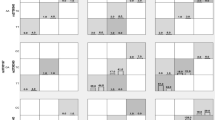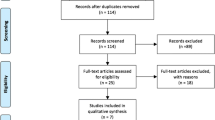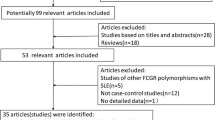Abstract
Objective
This study aimed to explore whether B‑cell lymphocyte kinase (BLK) polymorphisms are associated with susceptibility to systemic lupus erythematosus (SLE) in ethnically diverse populations.
Methods
We conducted a meta-analysis of the association between the BLK rs13277113 A/G, rs2736340 T/C, rs2248932 T/C, and rs2618476 G/A polymorphisms and SLE.
Results
Seventeen studies with 22,701 patients and 36,365 controls were included in the meta-analysis. The meta-analysis revealed a significant association between SLE and the BLK rs13277113 A allele (OR = 1.359, 95 % CI = 1.292–1.429, p < 1.0 × 10−8), and stratification by ethnicity indicated an association between this allele and SLE in Caucasians, Asians, and Africans (OR = 1.315, 95 % CI = 1.252–1.380, p < 1.0 × 10−8; OR = 1.415, 95 % CI = 1.287–1.555, p < 1.0 × 10−8; OR = 1.361, 95 % CI = 1.194–1.550, p = 3.6 × 10−6). A significant association between SLE and the rs2736340 T allele (OR = 1.354, 95 % CI = 1.286–1.426, p < 1.0 × 10−8) was also observed, and stratification by ethnicity indicated an association between the risk allele and SLE in Caucasians and Asians (OR = 1.333, 95 % CI = 1.259–1.412, p < 1.0 × 10−8; OR = 1.525, 95 % CI = 1.339–1.736, p < 1.0 × 10−8). Meta-analysis also revealed a significant association between SLE and the BLK alleles rs2248932 T and rs2618476 G (OR = 1.285 95 % CI = 1.228–1.345, p < 1.0 × 10−8; OR = 1.374, 95 % CI = 1.294–1.468, p < 1.0 × 10−8), and stratification by ethnicity indicated an association between these alleles and SLE in Caucasians and Asians.
Conclusions
This meta-analysis confirms that polymorphisms in the BLK alleles rs13277113 A/G, rs2736340 T/C, and rs2248932 T/C are associated with susceptibility to SLE in Caucasian and Asian populations.
Zusammenfassung
Ziel
Ziel dieser Studie war es, in ethnisch verschiedenen Populationen herauszufinden, ob Polymorphismen der B‑lymphozitären Kinase (BLK) mit Anfälligkeit für systemische Lupus erythematodes (SLE) in Zusammenhang stehen.
Methoden
Es wurde eine Metaanalyse des Zusammenhangs zwischen den BLK-Polymorphismen rs13277113 A/G, rs2736340 T/C, rs2248932 T/C und rs2618476 G/A sowie SLE durchgeführt.
Ergebnisse
17 Studien mit 22.701 Patienten und 36.365 Kontrollpersonen wurden in die Metaanalyse einbezogen. Die Metaanalyse zeigte einen signifikanten Zusammenhang zwischen SLE und dem Allel BLK rs13277113 A (OR = 1,359, 95 % CI = 1,292–1,429, p < 1,0 × 10− 8) und die Stratifizierung nach Ethnie wies auf einen Zusammenhang zwischen diesem Allel und SLE bei Menschen aus Europa, Asien und Afrika hin (OR = 1,315, 95 % CI = 1,252–1,380, p < 1,0 × 10− 8; OR = 1,415, 95 % CI = 1,287–1,555, p < 1,0 × 10− 8; OR = 1,361, 95 % CI = 1,194–1,550, p = 3,6 × 10− 6). Ebenfalls beobachtet wurde ein signifikanter Zusammenhang zwischen SLE und Allel rs2736340 T (OR = 1,354, 95 % CI = 1,286–1,426, p < 1,0 × 10− 8) und die Stratifizierung nach Ethnie deutete auf einen Zusammenhang zwischen diesem Risiko-Allel und SLE bei Menschen aus Europa und Asien hin (OR = 1,333, 95 % CI = 1,259–1,412, p < 1,0 × 10− 8; OR = 1,525, 95 % CI = 1,339–1,736, p < 1,0 × 10− 8). Die Metaanalyse zeigte auch einen signifikanten Zusammenhang zwischen SLE und den BLK-Allelen rs2248932 T und rs2618476 G (OR = 1,285 95 % CI = 1228–1,345, p < 1.0 × 10− 8; OR = 1,374, 95 % CI = 1,294–1,468, p < 1,0 × 10− 8). Die Stratifizierung nach Ethnie wies auf einen Zusammenhang zwischen diesen Allelen und SLE bei Menschen aus Europa und Asien hin.
Schlussfolgerungen
Diese Metaanalyse bestätigt, dass Polymorphismen in den BLK-Allelen rs13277113 A/G, rs2736340 T/C und rs2248932 T/C mit Anfälligkeit für SLE in der weißen und asiatischen Bevölkerung in Zusammenhang stehen.


Similar content being viewed by others
References
Lee YH, Nath SK (2005) Systemic lupus erythematosus susceptibility loci defined by genome scan meta-analysis. Hum Genet 118:434–443
Tsokos GC (2011) Systemic lupus erythematosus. N Engl J Med 365:2110–2121
Dymecki SM, Niederhuber JE, Desiderio SV (1990) Specific expression of a tyrosine kinase gene, blk, in B lymphoid cells. Science 247:332
Texido G, I‑h S, Mecklenbräuker I et al (2000) The B‑cell-specific Src-family kinase Blk is dispensable for B‑cell development and activation. Mol Cell Biol 20:1227–1233
Alarcón-Riquelme ME (2007) Recent advances in the genetics of autoimmune diseases. Ann N Y Acad Sci 1110:1–9
Hom G, Graham RR, Modrek B et al (2008) Association of systemic lupus erythematosus with C8orf13-BLK and ITGAM-ITGAX. N Engl J Med 358:900–909
Harley JB, Alarcón-Riquelme ME, Criswell LA et al (2008) Genome-wide association scan in women with systemic lupus erythematosus identifies susceptibility variants in ITGAM, PXK, KIAA1542 and other loci. Nat Genet 40:204–210
Simpfendorfer KR, Olsson LM, Orduño NM et al (2012) The autoimmunity-associated BLK haplotype exhibits cis-regulatory effects on mRNA and protein expression that are prominently observed in B cells early in development. Hum Mol Genet 21:3918–3925
Elghzaly AA, Metwally SS, El-Chennawi FA et al (2015) IRF5, PTPN22, CD28, IL2RA, KIF5A, BLK and TNFAIP3 genes polymorphisms and lupus susceptibility in a cohort from the Egypt Delta; relation to other ethnic groups. Hum Immunol 76:525–531
Namjou B, Ni Y, Harley IT et al (2014) The effect of inversion at 8p23 on BLK association with lupus in Caucasian population. PLoS ONE 9:e115614
Lee HS, Kim T, Bang SY et al (2014) Ethnic specificity of lupus-associated loci identified in a genome-wide association study in Korean women. Ann Rheum Dis 73:1240–1245
Kadota K, Mori M, Yanagimachi M et al (2013) Analysis of gender differences in genetic risk: association of TNFAIP3 polymorphism with male childhood-onset systemic lupus erythematosus in the Japanese population. PLoS ONE 8:e72551
Chen Y, Wu Q, Shao Y et al (2012) Identify the association between polymorphisms of BLK and systemic lupus erythematosus through unlabelled probe-based high-resolution melting analysis. Int J Immunogenet 39:321–327
Jarvinen TM, Hellquist A, Zucchelli M et al (2012) Replication of GWAS-identified systemic lupus erythematosus susceptibility genes affirms B‑cell receptor pathway signalling and strengthens the role of IRF5 in disease susceptibility in a Northern European population. Rheumatology 51:87–92
Zhou XJ, Lu XL, Nath SK et al (2012) Gene-gene interaction of BLK, TNFSF4, TRAF1, TNFAIP3, and REL in systemic lupus erythematosus. Arthritis Rheum 64:222–231
Sanchez E, Comeau ME, Freedman BI et al (2011) Identification of novel genetic susceptibility loci in African American lupus patients in a candidate gene association study. Arthritis Rheum 63:3493–3501
Yang W, Shen N, Ye DQ et al (2010) Genome-wide association study in Asian populations identifies variants in ETS1 and WDFY4 associated with systemic lupus erythematosus. PLoS Genet 6:e1000841
Zhang Z, Zhu KJ, Xu Q et al (2010) The association of the BLK gene with SLE was replicated in Chinese Han. Arch Dermatol Res 302:619–624
Suarez-Gestal M, Calaza M, Endreffy E et al (2009) Replication of recently identified systemic lupus erythematosus genetic associations: a case-control study. Arthritis Res Ther 11:R69
Yang W, Ng P, Zhao M et al (2009) Population differences in SLE susceptibility genes: STAT4 and BLK, but not PXK, are associated with systemic lupus erythematosus in Hong Kong Chinese. Genes Immun 10:219–226
Ito I, Kawasaki A, Ito S et al (2009) Replication of the association between the C8orf13-BLK region and systemic lupus erythematosus in a Japanese population. Arthritis Rheum 60:553–558
Han J‑W, Zheng H‑F, Cui Y et al (2009) Genome-wide association study in a Chinese Han population identifies nine new susceptibility loci for systemic lupus erythematosus. Nat Genet 41:1234–1237
Graham RR, Cotsapas C, Davies L et al (2008) Genetic variants near TNFAIP3 on 6q23 are associated with systemic lupus erythematosus. Nat Genet 40:1059–1061
Lee YH, Rho YH, Choi SJ et al (2007) The PTPN22 C1858T functional polymorphism and autoimmune diseases–a meta-analysis. Rheumatology 46:49–56
Lee YH, Woo JH, Choi SJ, Ji JD, Song GG (2009) Association of programmed cell death 1 polymorphisms and systemic lupus erythematosus: a meta-analysis. Lupus 18:9–15
Lee YH, Bae SC, Choi SJ, Ji JD, Song GG (2010) Associations between vitamin D receptor polymorphisms and susceptibility to rheumatoid arthritis and systemic lupus erythematosus: a meta-analysis. Mol Biol Rep 38:3643–3651
Higgins JP, Thompson SG (2002) Quantifying heterogeneity in a meta-analysis. Stat Med 21:1539–1558
DerSimonian R, Laird N (1986) Meta-analysis in clinical trials. Control Clin Trials 7:177–188
Egger M, Davey Smith G, Schneider M, Minder C (1997) Bias in meta-analysis detected by a simple, graphical test. BMJ 315:629–634
Rullo OJ, Tsao BP (2013) Recent insights into the genetic basis of systemic lupus erythematosus. Ann Rheum Dis 72:ii56–61
Sang A, Zheng YY, Morel L (2014) Contributions of B cells to lupus pathogenesis. Mol Immunol 62:329–338
Wang LD, Clark MR (2003) B‑cell antigen-receptor signalling in lymphocyte development. Immunology 110:411–420
Cornall RJ, Goodnow CC (eds) (2008) B cell antigen receptor signalling in the balance of tolerance and immunity. Novartis Foundation symposium
Nemazee D, Weigert M (2000) Revising B cell receptors. J Exp Med 191:1813–1818
Cambier JC (2013) Autoimmunity risk alleles: hotspots in B cell regulatory signaling pathways. J Clin Invest 123:1928–1931
Fan Y, Tao J‑H, Zhang L‑P, Li L‑H, Ye D‑Q (2011) Association of BLK (rs13277113, rs2248932) polymorphism with systemic lupus erythematosus: a meta-analysis. Mol Biol Rep 38:4445–4453
Acknowledgement
This study was supported by a Korea University grant.
Author information
Authors and Affiliations
Corresponding author
Ethics declarations
Conflict of interest
G. G. Song and Y. H. Lee state that there are no conflicts of interest.
The accompanying manuscript does not include studies on humans or animals.
Additional information
Redaktion
U. Müller-Ladner, Bad Nauheim
U. Lange, Bad Nauheim
Rights and permissions
About this article
Cite this article
Song, G.G., Lee, Y.H. Association between BLK polymorphisms and susceptibility to SLE. Z Rheumatol 76, 176–182 (2017). https://doi.org/10.1007/s00393-016-0072-8
Published:
Issue Date:
DOI: https://doi.org/10.1007/s00393-016-0072-8




